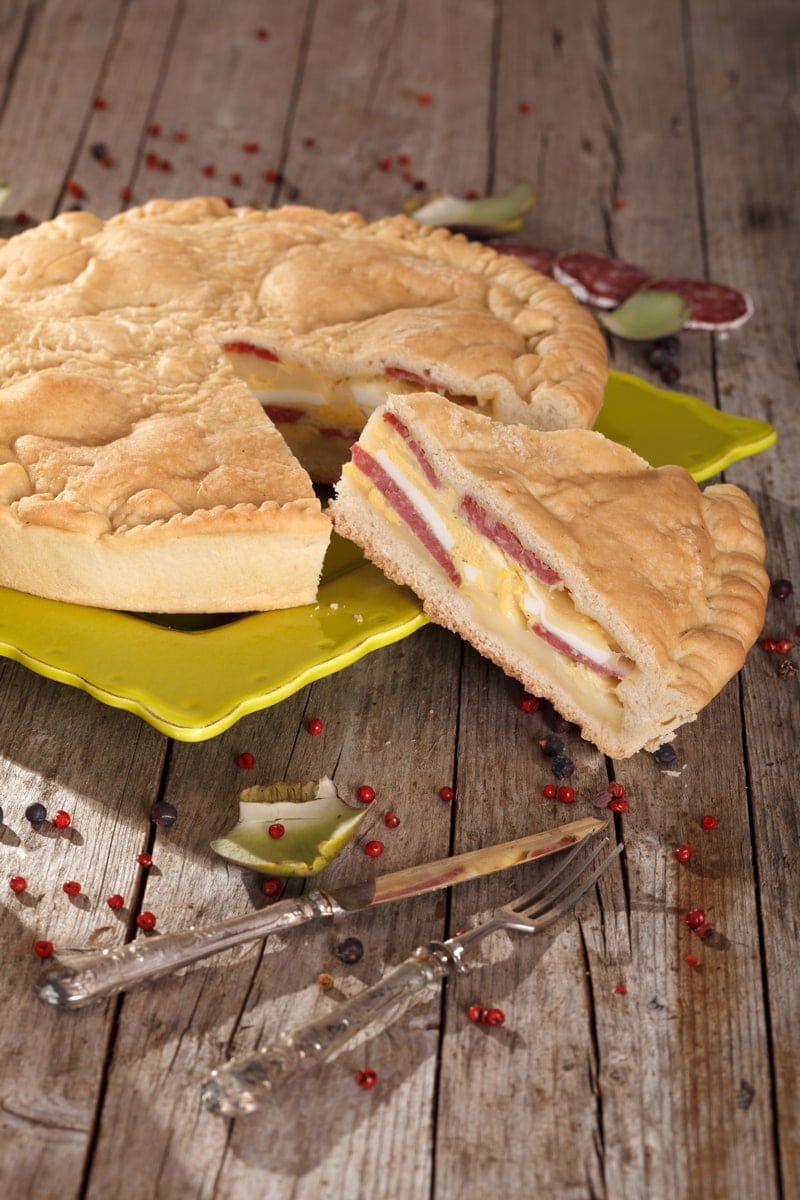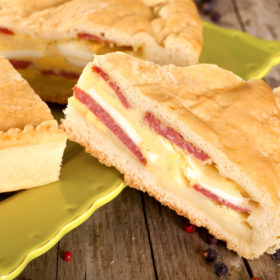Pizza rustica is a round, traditional Italian savory Easter pie layered with a number of meat and cheeses, topped with a crust to enclose the entire dish. It’s served as a hearty antipasto before the main holiday meal, but the leftovers (if you have any!) can serve as a snack or even a meal once the holiday has passed.
You don’t have to wait for Easter to make this lovely dish, however. Pizza rustica is a simple yet impressive dish to serve to your family for dinner, pair with a side salad for an easy lunch or take as an antipasto to your next get-together.
Pizza rustica is a savory pie, similar to Torta Pasqualina, that is cut into thick wedges and served as at room temperature as an antipasto, traditionally at Easter. “Pizza” in Italian means pie. The deep dish you might get delivered on Saturday night is just one variation of the many different kinds of pizza in traditional Italian cuisine.
When it comes to pizza rustica, forget about that delivery slice. Instead picture prosciutto, salami and capicola (among others) beautifully layered between, or mixed with eggs and mozzarella, ricotta, provolone and other cheeses, all surrounded by a tall handmade crust.
In Italy pizza rustica is associated with Easter. This is the second largest holiday season for Italians, just behind Christmas. Along with other religious observances and celebrations is the Triduum – Holy Thursday, Friday and Saturday. These days are filled with church services and other traditions.
Pizza rustica, because it celebrates the end of Lent, is made at the end of the week when the Triduum occurs. It may be eaten on Easter Sunday itself, and may also be enjoyed on Easter Monday, when many families head outside for picnics or cookouts. Whenever you enjoy it, pizza rustica is a festive treat.
Though it goes by many names, and is now popular throughout Italy and wherever anyone carries on Italian culinary traditions, pizza rustica emerged from Naples around the 1600’s. Even then it was a traditional Easter dish, a way to break the Lent fast of abstaining from meat, eggs and dairy. This cheesy, satisfying antipasto is the perfect way to celebrate the end of that fasting as well as the holiday itself.
“Pizza rustica” may also be known as pizza ripiena or pizza chiena, among a number of other variations, based on the Italian region or dialect referring to it. Each name means roughly the same thing – a “stuffed” pizza. In America this dish, which was brought over by Neapolitans and other Italians emigrating to the States, is often known as pizzagaina.

Stateside the dish may sometimes look a little different than its traditional counterpart. Some Italian cooks had a hard time finding the cured meats and salami the original recipes call for, so they experimented with ham, pepperoni and other ,eats. The same is true of “basket cheese” and the other cheeses used.
Is one version superior to the other? Is the traditional pizza rustica always going to beat out newer versions from other areas of the world? Not really. Pizza rustica is a dish that allows for an array of experimentation and substitution. So if you don’t care for salami or prosciutto, feel free to try other meats. In the end, creating a sturdy deep dish pie filled with meat and cheese is going to be delicious any way you slice it.
Go searching for traditional pizza rustica recipes – of which there are many, with numerous regional variations – and “basket cheese” is something you’ll encounter quite often. This is a fresh cheese, made from cow’s milk, first drained and then pressed in baskets, giving it a distinctive basket weave imprint pattern. But of course not everyone has access to fresh made cheese such as this, which is why more modern recipe accommodate a wider array of cheese – and meat! – options. Ricotta, a soft and creamy cheese, is a good substitute for basket cheese.
Once cooled, pizza rustica will last for about four or five days in your fridge in an airtight container or wrapped well in plastic. If you want to freeze it, wrap it tightly in plastic and then foil, or use plastic freezer bags. There it should keep well for months.
You can also freeze just the dough, wrapped and stored in the same manner, so that next time you want to make this dish or any number of others you can simply pull out a package of pre-made dough to save time.
